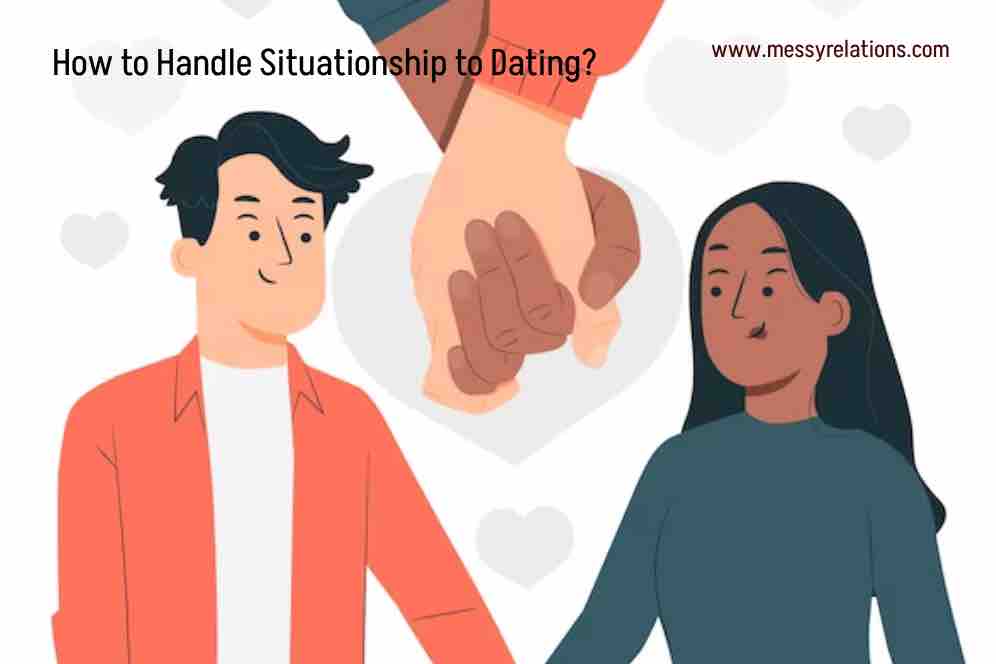Transitioning from a situationship to a dating arrangement can be a path filled with uncertainties and questions. It’s a journey from ambiguity to something more defined and committed. In this comprehensive guide, we’ll explore how to navigate this transition effectively, ensuring both partners are comfortable and their needs are met.
Understanding the Transition
The shift from a situationship to a dating arrangement involves moving from an undefined, casual connection to a more structured and committed relationship. This transition requires open communication, mutual understanding, and a willingness to adapt.
1. Assess Your Feelings
Begin by introspecting your feelings about the situationship. Ask yourself if you’re ready for a more committed relationship and if you see long-term potential with your partner. Being honest with yourself about your feelings is the first step in this transition.
2. Always Talk About Your Intentions
Once you’ve assessed your feelings, the next step is to communicate them to your partner. Approach the conversation with openness and honesty. Express your desire to transition the relationship into a more traditional dating arrangement, and explain your reasons clearly.
3. Understand Your Partner’s Perspective
It’s equally important to understand your partner’s perspective. Give them space to share their thoughts and feelings about transitioning from a situationship to dating. Listen actively and empathetically to their responses.
4. Be Upfront About Your Expectations
Transitioning to a dating arrangement involves setting clear expectations. Discuss what you both want from the relationship, including commitment levels, exclusivity, and future plans. This clarity can prevent misunderstandings later on.
5. Redefine Boundaries
With a change in the relationship dynamic, it’s crucial to redefine boundaries. Discuss and agree on new boundaries that are appropriate for a more committed relationship. This might include frequency of communication, spending time together, and other relationship parameters.
6. Take it Slow
It’s often wise to take things slow during this transition. Avoid rushing into labels or commitments without giving yourselves time to adjust to the new dynamics of the relationship.
7. Build Trust
Trust is a vital component in any relationship, more so in one that’s transitioning from a situationship. Focus on building trust through consistent actions, reliability, and open communication.
8. Balance Independence with Intimacy
While moving towards a more committed relationship, it’s important to balance your need for independence with the intimacy of dating. Ensure that both partners feel comfortable with the level of closeness and personal space.
9. Handle Emotional Vulnerabilities
Transitioning from a situationship to dating can bring emotional vulnerabilities to the surface. Be prepared to handle emotions like fear of commitment, insecurities, or past relationship traumas. Addressing these emotions openly can strengthen the relationship.
10. Celebrate the New Phase
Embrace and celebrate this new phase of your relationship. Acknowledge the growth and progress you’ve made from a situationship to a more committed arrangement. Enjoy the journey of getting to know each other on a deeper level.
11. Be Open to Changes
Be open to changes and adjustments as you navigate this new phase. Every relationship evolves, and being adaptable can help you manage any challenges that arise.
12. Seek Support if Needed
Don’t hesitate to seek support from friends, family, or a professional counselor during this transition. Getting external perspectives can provide valuable insights and support.
Transitioning from a situationship to a dating arrangement is a significant step that requires careful consideration and effort from both partners. It’s a journey of transforming an undefined connection into something more stable and fulfilling. By focusing on open communication, mutual understanding, and emotional readiness, you can navigate this transition smoothly. Remember, every relationship is unique, and embracing the journey with patience and empathy can lead to a rewarding and meaningful connection.
What To Do If Your Situationship Started Dating Someone Else?
Discovering that your situationship partner has started dating someone else can be a confusing and emotionally challenging situation.
Firstly, it’s crucial to recognize the inherent nature of situationships. These relationships are typically undefined and casual, often lacking explicit commitments. This understanding is key in managing your expectations and reactions when faced with the news that your situationship partner is dating someone else.
1. Process Your Feelings
Begin by allowing yourself to process your emotions. It’s natural to feel a range of emotions, from hurt and betrayal to confusion and jealousy. Acknowledge these feelings without judgment. Understanding your emotional response is the first step in deciding how to move forward.
2. Reflect on the Situationship
Reflect on the nature of your situationship. Consider the conversations you’ve had about exclusivity and commitment. Sometimes, the lack of defined boundaries in a situationship can lead to misunderstandings about what is acceptable behavior.
3. Communication with Your Partner
Have an open and honest conversation with your partner. Express how you feel about them dating someone else. This conversation can provide clarity, help you understand their perspective, and decide on the future of your relationship.
4. Assessing Your Wants and Needs
Take time to reassess what you want and need from a relationship. Are you looking for commitment and exclusivity? Understanding your own relationship goals is crucial in determining your next steps.
5. Dealing with Jealousy and Insecurity
Jealousy and insecurity are common reactions in this situation. Address these feelings by focusing on self-care and self-worth. Remember, your value is not diminished by someone else’s actions.
6. Considering Moving On
Sometimes, the best course of action might be to move on. If the situationship is no longer meeting your needs or causing you distress, it may be healthier to let go and focus on your well-being.
7. The Possibility of Remaining Friends
If you and your partner are on good terms, consider the possibility of remaining friends. However, ensure that you are emotionally comfortable and ready for this transition.
8. Seeking Support from Friends and Family
Don’t hesitate to lean on your support network during this time. Friends and family can offer perspective, comfort, and advice as you navigate this emotionally challenging situation.
9. Learning from the Experience
Every relationship, even a situationship, offers opportunities for learning and growth. Reflect on what this experience has taught you about relationships, communication, and your own emotional needs.
10. Focusing on Personal Growth
Use this experience as an opportunity for personal growth. Engage in activities that bring you joy and fulfillment. Focusing on your personal development can be a positive way to move forward.
11. Embracing the Future
Look to the future with optimism. Endings also signify new beginnings. Embrace the possibilities that lie ahead, whether that means new relationships, new experiences, or a deeper understanding of yourself.
12. Professional Guidance if Needed
If you find it particularly difficult to cope, consider seeking professional guidance. A counselor or therapist can provide strategies to manage your emotions and move forward in a healthy way.
Finding out that your situationship partner has started dating someone else can be a tough pill to swallow. However, by processing your emotions, communicating openly, reassessing your needs, and focusing on your well-being, you can navigate this situation effectively.




